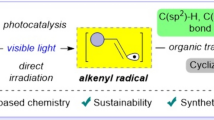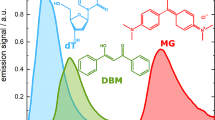Abstract
This work is devoted to the problem connected with rhodopsin activation. Electrostatic forces involved in photoisomerization of retinal are considered. It is suggested that the repulsion force and rotating moment between electric dipole moments of methyl groups on the C5 and C13 atoms of retinal can promote isomerization upon light absorption because the π-π* transition is accompanied by a decrease in the potential barrier for torsional rotations around the C11–C12 bond.
Similar content being viewed by others
References
Cviklinski, A. R., and Tajbaksh, E. M. (2002) Eur. Phys. J., E9, 427–434.
Potapov, V. M. (1988) Stereochemistry [in Russian], Nauka, Moscow.
Kalamkarov, G. R., and Ostrovsky, M. A. (2002) Molecular Mechanisms of Visual Reception [in Russian], Nauka, Moscow, p. 279.
Peteanu, L. A., Schoenlein, R. W., Qing Wang, Mathies, R. A., and Shank, Ch. V. (1993) Proc. Natl. Acad. Sci. USA, 90, 11762–11766.
De Grip, W., de Lange, F., Bovee, P., Verdegem, P. J. E., and Lugtenburg, J. (1997) Pure & Appl. Chem., 89, 2091–2098.
Zimmerman, A. L. (1998) Cell Physiology Source Book (Sperelakis, N., ed.) 2nd Edn., University of Cincinnati, pp. 718–725.
Zuker, C. S. (1996) Proc. Natl. Acad. Sci. USA, 93, 571–576.
Kosower, E. M. (1998) Molecular Mechanisms for Sensory Signals, Princeton University Press, Princeton, NJ, USA.
Neiland, O. Ya. (1990) Organic Chemistry [in Russian], Vysshaya Shkola, Moscow.
Keshtova, S. V. (2004) Analysis of Empirical and Non-empirical Methods of Determination of Partial Charge of Atoms and Molecules [in Russian], Moscow State University Publishers GROMOS 96.
Kalugin, O. N., Pazyura, Yu. I., and Kolesnik, Ya. V. (2005) Khimiya, 13(36), No. 669, All-Russian Chemical Research Center.
Salgado, G. F. J., Struts, A. V., Tanaka, K., Fujioka, N., Nakanishi, K., and Brown, M. F. (2004) Biochemistry, 43, 12819–12828.
Parsell, E. (1971) Electricity and Magnetism [in Russian], Nauka, Moscow.
Fliger, W. (1982) Structure and Dynamics of Molecules [Russian translation], Mir, Moscow.
Shaitan, C. V. (1999) Soros Obrazovat. Zh., No. 5, 8–13.
Baudry, J., Crouzy, S., Roux, B., and Smith, J. C. (1999) Biophys. J., 76, 1909–1917.
Author information
Authors and Affiliations
Corresponding author
Additional information
Original Russian Text © N. S. Vassilieva-Vashakmadze, R. A. Gakhokidze, A. R. Gakhokidze, 2008, published in Biokhimiya, 2008, Vol. 73, No. 6, pp. 909–912.
Rights and permissions
About this article
Cite this article
Vassilieva-Vashakmadze, N.S., Gakhokidze, R.A. & Gakhokidze, A.R. Mechanism of photoisomerization of the rhodopsin chromophore. Biochemistry Moscow 73, 730–732 (2008). https://doi.org/10.1134/S0006297908060151
Received:
Revised:
Published:
Issue Date:
DOI: https://doi.org/10.1134/S0006297908060151




